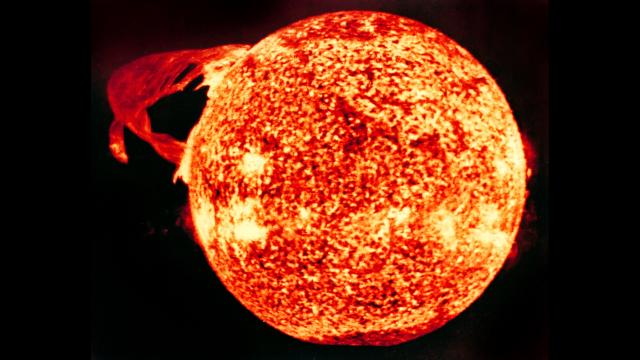When all sources of errors have been ruled out and 4096 phoney votes have still been given to a candidate, who do you blame? In some cases, these kinds of glitches may be coming from outer space, according to scientists who discussed this cosmic conundrum today at the annual meeting of American Association for the Advancement of the Sciences in Boston. Just to be clear, this does NOT mean that aliens influenced the 2016 US election.
Image: NASA
Every day, the Earth falls victim to an onslaught of high-energy particles originating from throughout the galaxy and even our Sun. These particles, especially neutrons, can interact with the semiconductors powering computer chips and cause an assortment of glitches in all of our electronics. Such interactions have been an aviation issue for several decades, but in recent years, concern over cosmic rays harming mobile phones, electronic cars and even voting machines has increased. Now, consumer electronic companies are attempting to manufacture their devices to be more hardy against every day cosmic rays, and bigger space weather events like solar storms.
“Apparently there were 3 million [illegal] votes in our last election,” joked Bharat Bhuva, professor of electrical engineering at Vanderbilt University during a talk at AAAS. “It must have been solar flares.”
To be clear, it’s incredibly unlikely (read: Impossible) that solar flares were the source of three million votes for either candidate in the 2016 US election. But the detrimental effects of high-energy neutrons on our electronics are real. When neutrons from space weather’s constant barrage collide with the silicon in our microchips, they can produce secondary charged particles, causing voltage in transistors and glitches in the devices, so-called “single event upsets.” Scientists know these happen, but determining whether space weather caused a glitch is frequently a matter of ruling out every other possibility first, said Bhuva. More obvious effects, like a computer crash, would usually require an extreme space weather event, for instance, a large coronal mass ejection from the Sun.
Our daily neutron showers can produce both soft errors and hard errors, those that can be fixed with a reboot and those that can’t, and many of the events you won’t even notice. However, in his talk today, Bhuva brought up a past analysis which found that one such cosmic ray event could have caused 4096 incorrect votes in a 2003 local Belgian election.
These neutrons can’t be blocked, explained Bhuva — doing so would take several metres of concrete, and you probably aren’t planning to bring concrete with you wherever you go.
The key, then, is to mitigate these errors by building redundancies into devices. “NASA puts three copies of everything on all of their spaceships,” explained Jonathan Pellish, aerospace engineer from the NASA Goddard Space Flight Center. “On all the Apollo missions we had three computers doing the same thing every second,” since the odds of two issues occurring in two chips simultaneously are very low. Dealing with the effects of space weather in consumer electronics also requires lots of testing to make sure chips still work despite the subatomic onslaught.
So, how do you recreate space weather on Earth to test your electronics out? If you guessed a particle accelerator, you’re right. Certain neutron sources like particle accelerators can produce the equivalent of a hundred years of neutrons like those in cosmic rays in just an hour, explained Christopher Frost, scientist at the Rutherford Appleton Laboratory (RAL) working on ChipIR, an instrument in the United Kingdom that will help test neutrons’ effects on silicon chips. Microchip builders can use such facilities at Los Alamos National Laboratory in New Mexico, and soon ChipIR on the accelerator at RAL, to see the effects of a long-term barrage of cosmic neutrons on their chips, and then decide how they’d like to react.
“You don’t want to protect everything,” Frost told Gizmodo. “You want to hone in on the problematic bits. If a smartphone fails once, it’s irritating,” but the real goal is to prevent systematic failure.
Frost wouldn’t say how much of this space weather testing has happened on our voting machines, but noted that it’s now an important part of electronics testing in general. Engineers are aware of these problems, said Bhuva, and continue to work on them. Again, please, please don’t freak out about cosmic rays tampering with our recent US election.
